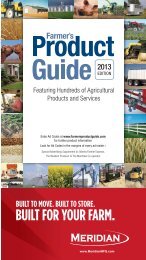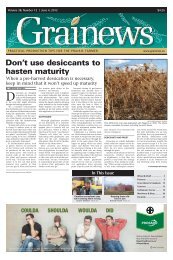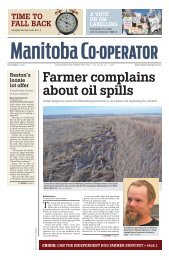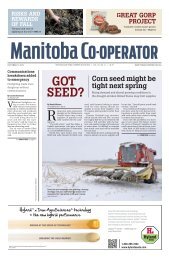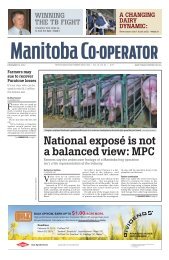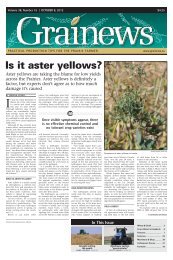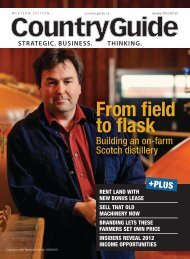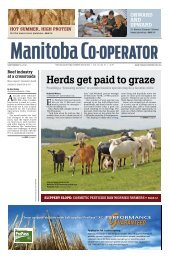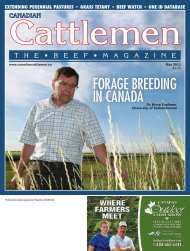Create successful ePaper yourself
Turn your PDF publications into a flip-book with our unique Google optimized e-Paper software.
6<br />
FROM PAGE ONE<br />
SNOWFAKE STORM – AFTERMATH<br />
Above left: The hailstorm that hit the Snowflake area July 4 destroyed many crops, including this field of canola. Above right: It’s no wonder hail is called<br />
the big white combine. There’s nothing left of this Snowflake area canola crop hit by a hail and wind storm July 4. PHOTOS: ALLAN DAWSON<br />
Severe weather hit much of<br />
southwest and south-central<br />
Manitoba July 4. The Snowflake area<br />
was hard hit by hail and high<br />
winds at around 6:30 A.M. and then<br />
again around 8:00 A.M. This photo<br />
(above) taken at Double Diamond’s facility<br />
near Snowflake at 8:00 A.M. shows<br />
the rain blowing over the shed<br />
roof. Many beautiful crops were<br />
completely destroyed. Some grain<br />
bins were wrecked and many tress<br />
were toppled and stripped of<br />
their leaves. PHOTO: RYAN YOUNG<br />
EvEryonE is invitEd to<br />
WAdo’s 8 th AnnuAl<br />
Ag rEsEArch FiEld dAy<br />
FridAy – July 20 th At thE nEW WAdo hEAdquArtErs<br />
Just WEst oF thE John dEErE dEAlErship on<br />
highWAy #3 in MElitA, MB.<br />
Be there at 12 Noon sharp for the Grand Opening Celebration<br />
of WADO’s new research facility in Melita, featuring our Minister<br />
of Agriculture, Food, and Rural Initiatives Ron Kostyshyn.<br />
BBq lunch to FolloW<br />
Research plot tour to begin at 1 pm – highlighting the latest canola varieties,<br />
cereal crops, soybeans, corn research, hemp research, winter wheat varieties and<br />
agronomy, intercropping research, special<br />
crops, cover crops, Ethiopian Mustard,<br />
forage restoration, and much more.<br />
We can confidently say that things look<br />
much better than last year, so we hope<br />
you can join us.<br />
contact: scott day – 204-534-7633 or scott chalmers 204-522-5015<br />
for more information.<br />
The storm that roared through the Snowflake area July 4<br />
destroyed crops, grain bins and shelter belts, including these trees<br />
at Arnie and Carol Falk’s. PHOTO: ALLAN DAWSON<br />
Hail July 4 turned this field east of Snowflake into soybean sticks. The storm also<br />
destroyed this field of wheat (above right) and many grain bins. PHOTO: ALLAN DAWSON<br />
The Manitoba Co-operator | July 12, 2012<br />
OPEN MARKET Continued from page 1<br />
Dakota State University. Grain<br />
companies typically use the<br />
basis — the difference between<br />
the cash and futures price — to<br />
encourage or discourage deliveries,<br />
he said.<br />
Usually the basis is widest,<br />
resulting in a lower price to the<br />
farmer, at harvest time when<br />
elevator companies are flooded<br />
with grain, he said. They are the<br />
narrowest in the middle of winter<br />
when deliveries are reduced.<br />
Since 2007, world grain markets<br />
have become much more<br />
volatile and so has the fluctuation<br />
in basis, Olson said. Before<br />
2007, the wheat basis in North<br />
Dakota ranged from 30 cents a<br />
bushel under the futures price<br />
to 10 cents over for a 40-cent<br />
spread. Now the spread can be<br />
as much as $3. Being able to<br />
store grain when the basis is<br />
wide is one of the simplest ways<br />
of dealing with the risk, he said.<br />
“In the last few years the market<br />
has paid you substantial<br />
rewards for being careful about<br />
watching that spread in the cash<br />
and futures,” Olson said.<br />
Some of the grain contracts in<br />
the U.S. give the buyer the right<br />
to determine when the grain is<br />
delivered.<br />
“Storage will be<br />
king.”<br />
VAUGHN CONE<br />
“You don’t deliver when you<br />
want to — you deliver whenever<br />
the buyer wants it,” he said.<br />
“And that could be two weeks<br />
from now or two months from<br />
now. It could be 12 months from<br />
now.” Using futures and options<br />
markets is another way to offset<br />
price risk, but it’s important<br />
to know the difference between<br />
hedging (locking in a grain price)<br />
and speculating (gambling<br />
prices will go a certain direction),<br />
Olson said.<br />
The Minneapolis wheat<br />
futures market matches most<br />
closely the type of wheat grown<br />
in Western Canada, he said.<br />
There’s not enough trading on<br />
ICE Future’s Winnipeg market,<br />
he said.<br />
An open market is a big<br />
change for Western Canadian<br />
farmers, said Dan Hawkins of<br />
FarmLink Marketing Solutions.<br />
“We’ll have to be patient for<br />
markets,” he said.<br />
Sometimes buyers will want a<br />
No. 3 wheat, not a No. 1 and vice<br />
versa.<br />
“We have to sell into the<br />
strengths when the strengths<br />
come,” he said.<br />
It’s going to be different for<br />
grain buyers, too.<br />
“I had one buyer tell me that<br />
his trading area would triple in<br />
size because instead of knowing<br />
just what durum and wheat<br />
samples were in a 50-mile radius<br />
of his elevator he now needed to<br />
know within a hundred miles,”<br />
Hawkins said.<br />
allan@fbcpublishing.com



